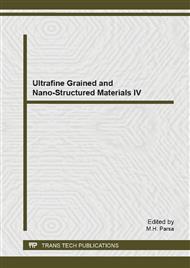p.825
p.831
p.836
p.841
p.846
p.851
p.857
p.862
p.869
Preparation of Nano Crystalline Titanium Dioxide by Microwave Hydrothermal Method
Abstract:
Titanium dioxide (TiO2) nanoparticles due to their exclusive physical, chemical and electrical properties are widely used as a heterogeneous catalyst and catalytic support in the chemical reactions, a semiconductor for photocatalysis reactions and additives in the membrane processes. The TiO2 nanoparticles are also utilized in solar cells, gas sensors, pigments and etc. Efficiency of these nanoparticles in various applications is dramatically dependent on their size. Various techniques such as combustion flame synthesis and conventional hydrothermal methods have been used to prepare TiO2 nanoparticles, but few synthesis techniques can reproducibly produce particles below 10 nm. In this study, the TiO2 nanoparticles in rutile phase were synthesized by microwave assisted hydrothermal method by controlling the crystallization time and temperature. Titanium tetrachloride (TiCl4) was used as a titanium precursor. The synthesized nanoparticles were characterized by X-ray powder diffraction (XRD) and Scanning Electron Microscope (SEM) analysis. The XRD pattern showed that the rutile phase of the TiO2 nanoparticles was successfully synthesized by the proposed method with the average crystal size of 4nm. Finally, the prepared Titanium dioxide (TiO2) nanoparticles were as a hydrophobic additive in the polymeric ultrafiltration membranes in order to reduce the membrane fouling.
Info:
Periodical:
Pages:
846-850
Citation:
Online since:
November 2013
Price:
Сopyright:
© 2014 Trans Tech Publications Ltd. All Rights Reserved
Share:
Citation:


